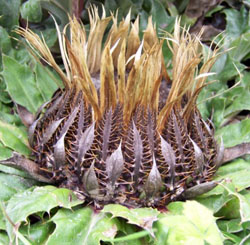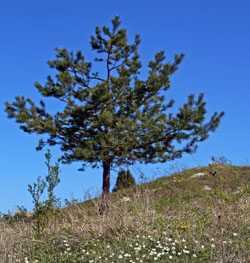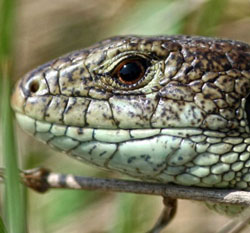
|
STAWSKA GÓRA (PLH 060018)
The Stawska Góra site PLH 060018 is located in the Chełm Hills region (eastern part of the Lublin Upland), about 8 km northwest of Chełm and 1.5 km from the village of Staw. It encompasses part of the Upland's peaks known as Góra Czubatka and is entirely within the floral reserve created to preserve its steppe vegetation. The area of the reserve is part of State Treasury lands managed by the Chełm Township authorities. The reserve is 4.9 ha in size.
The greatest treasure of this small site is Carlina onopordifolia. This is only one of two places where this plant occurs in the Lublin region and one of five known throughout Poland. The existence of Carlina onopordifolia at Stawska Góra was already cited in the literature in 1881, whereas the reserve was established in 1956.
Along with Carlina onopordifolia, other thermophilous and calciphilous steppe species comprising the xerothermic grasslands are also protected in the reserve. The grasslands themselves, due to great anthropomorphic pressure, do not form typical grassland species' assemblages here, but are nonetheless characterized by great species richness. A total of 210 plant species have been confirmed on the reserve, including 30 acknowledged as rare and 8 under strict legal protection: Carlina onopordifolia and Carlina acaulis, Adonis vernalis, Anemone sylvestris, Aster amellus, Aquilegia vulgaris, Prunus fruticosa, Gentiana cruciata. Three are partially protected: Primula veris, Viburnum opulus and Frangula alnus. Additionally, Prunus fruticosa, Carlina onopordifolia and Senecio macrophyllus are listed in the Polish Red Data Book of Plants.
The xerothermic grasslands contain rich faunal life. 600 species of various systematic groups have been found in this small area. Among them are 27 listed in the Polish Red Data Book of Animals as nearly extinct or threatened. The most numerous species' group are the invertebrates, with the butterflies being the best studied among them. Over 300 butterfly species have been observed here, with two under protection: Papilio machaon and Proserpinus proserpina, while others are rare, occurring in only a few known areas in Poland. Most of the reserve's rare invertebrate species are limited in their ability to spread and have survived here because the appropriate conditions of their steppe-like micro-habitats have continued to exist.
The main threat to the rare forms of plants and animals in this area is natural succession. In the past, a fragment of the grassland was used as pasture, which minimized the growth of shrubs and trees. After grazing ceased, the expanding growth of shrubs and trees made it impossible for the photophilous steppe vegetation to grow and it began to disappear. This area must be actively managed in order to maintain the habitat of the many rare steppe species occurring here.
     
|

|



|








